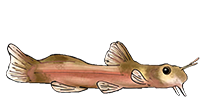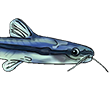Please ID new Twigs/Farlowellas - second one: Twig B!
-
parrot1974
- Posts: 46
- Joined: 12 Jul 2013, 19:18
- My cats species list: 50 (i:0, k:0)
- My aquaria list: 5 (i:0)
- My BLogs: 7 (i:5, p:236)
- Spotted: 16
- Location 2: Isle of Wight
Please ID new Twigs/Farlowellas - second one: Twig B!
Right, Twig B is not F. vittata - I know that much!
He is slightly different.
Characteristics:
- Incomplete row of median scutes
- Breeding odontodes are evident at this age (I get the impression he's not yet mature) and he's only about 100-110 mm. His 2nd and 3rd lateral scutes are thickened and form keeled ridges, I think. I know to some extent he is young and his odontodes may never get big, but I can see them without magnification.
So far, that takes me to a choice between F. taphorni and F. curtirostra. However, his body depth is definitely less than his snout-mouth length, which leads me to F. taphorni. Given the pics, does anyone feel that's a bad call? Please let me know, as am trying to get the hang of this ID stuff!
A few more interesting points - he has a deep gold belly, which darkens to a very obvious brown just past his anal fin. He also has an interesting caudal fin pattern and his rostrum is slightly more bulbous than F. vittata.
Finally, his behaviour is very different to any of the other twigs I own. When held, he doesn't struggle, just judders slightly - makes it very difficult to take decent photos!
Any help appreciated, thanks.
He is slightly different.
Characteristics:
- Incomplete row of median scutes
- Breeding odontodes are evident at this age (I get the impression he's not yet mature) and he's only about 100-110 mm. His 2nd and 3rd lateral scutes are thickened and form keeled ridges, I think. I know to some extent he is young and his odontodes may never get big, but I can see them without magnification.
So far, that takes me to a choice between F. taphorni and F. curtirostra. However, his body depth is definitely less than his snout-mouth length, which leads me to F. taphorni. Given the pics, does anyone feel that's a bad call? Please let me know, as am trying to get the hang of this ID stuff!
A few more interesting points - he has a deep gold belly, which darkens to a very obvious brown just past his anal fin. He also has an interesting caudal fin pattern and his rostrum is slightly more bulbous than F. vittata.
Finally, his behaviour is very different to any of the other twigs I own. When held, he doesn't struggle, just judders slightly - makes it very difficult to take decent photos!
Any help appreciated, thanks.
-
parrot1974
- Posts: 46
- Joined: 12 Jul 2013, 19:18
- My cats species list: 50 (i:0, k:0)
- My aquaria list: 5 (i:0)
- My BLogs: 7 (i:5, p:236)
- Spotted: 16
- Location 2: Isle of Wight
Re: Please ID new Twigs/Farlowellas - second one: Twig B!
Extra pics, in case they help!
Thanks.
Thanks.
-
Karsten S.
- Posts: 609
- Joined: 26 May 2007, 22:35
- My images: 30
- Spotted: 20
- Location 1: Ludwigsburg - Germany
- Location 2: Ludwigsburg - Germany
Re: Please ID new Twigs/Farlowellas - second one: Twig B!
Hello Petra,
this one is difficult...
Caudal fin pigmentation is different as well as belly scutes, do you have a better pic of these ?!
Any information about the origins of these ?
I would exclude F. taphorni as well as F. curtirostra due to the shape of snout/rostrum.
Cheers,
this one is difficult...
Caudal fin pigmentation is different as well as belly scutes, do you have a better pic of these ?!
Any information about the origins of these ?
I would exclude F. taphorni as well as F. curtirostra due to the shape of snout/rostrum.
Cheers,
--
Karsten
Karsten
-
parrot1974
- Posts: 46
- Joined: 12 Jul 2013, 19:18
- My cats species list: 50 (i:0, k:0)
- My aquaria list: 5 (i:0)
- My BLogs: 7 (i:5, p:236)
- Spotted: 16
- Location 2: Isle of Wight
Re: Please ID new Twigs/Farlowellas - second one: Twig B!
Thanks, Karsten. Yes after I posted that, I had a look at f.taphorni and f.curtirostra and re-read the information: realised that when they talked about odontodes on the head, they were nothing like mine, so I was totally wrong 
I think you are right, in that it all seems to come down to whether the belly scutes have an incomplete row of median scutes or not. I have attached some more pics of them - if you look carefully, there is definitely one scute at the top, but the bottom three look like they could be, but they aren't clear. So it's either 0-1 or 2-5.
The closest I can get to them is f. knerii. That's by saying there's three rows of scutes. If I say there is an incomplete row, then I end up with ones that it can't be, due to length of rostrum or the fact that it does have reticulations on it.
According to Retzer & Page, its caudal fins are figure 4 state 2, with a distinct clear ocellus bar.
Anyway, my head is now hurting from this, so would appreciate any help, as ever
Thanks,
Petra
I think you are right, in that it all seems to come down to whether the belly scutes have an incomplete row of median scutes or not. I have attached some more pics of them - if you look carefully, there is definitely one scute at the top, but the bottom three look like they could be, but they aren't clear. So it's either 0-1 or 2-5.
The closest I can get to them is f. knerii. That's by saying there's three rows of scutes. If I say there is an incomplete row, then I end up with ones that it can't be, due to length of rostrum or the fact that it does have reticulations on it.
According to Retzer & Page, its caudal fins are figure 4 state 2, with a distinct clear ocellus bar.
Anyway, my head is now hurting from this, so would appreciate any help, as ever
Thanks,
Petra
-
Karsten S.
- Posts: 609
- Joined: 26 May 2007, 22:35
- My images: 30
- Spotted: 20
- Location 1: Ludwigsburg - Germany
- Location 2: Ludwigsburg - Germany
Re: Please ID new Twigs/Farlowellas - second one: Twig B!
Hello Petra,
I'm not sure if F. knerii has ever been imported. Type locality is Ecuador, from this country there are no imports.
They might also come from Peru as they are reported from Pastaza area but this would be a bit far to transport a catfish with a rather low interest in the market when you can have similar species from much closer habitats.
This is really a difficult one. It could be some oddball of a known species or something new. Unfortunately I don't have much experience concerning the variability of these species.
To summarize we have some undistinct median belly scutes and it is unclear if we have a median abdominal scute (which would rule out acus group). The caucal fin state is closer to 2 (knerii group) than to 1 (acus group).
Within acus group the only option would be F. vittata which cannot be completely ruled out as per Retzer & page descition:
Possibly a new member of knerii group ?!
Any chance to find out anything about the origin ?
Cheers,
I'm not sure if F. knerii has ever been imported. Type locality is Ecuador, from this country there are no imports.
They might also come from Peru as they are reported from Pastaza area but this would be a bit far to transport a catfish with a rather low interest in the market when you can have similar species from much closer habitats.
This is really a difficult one. It could be some oddball of a known species or something new. Unfortunately I don't have much experience concerning the variability of these species.
To summarize we have some undistinct median belly scutes and it is unclear if we have a median abdominal scute (which would rule out acus group). The caucal fin state is closer to 2 (knerii group) than to 1 (acus group).
Within acus group the only option would be F. vittata which cannot be completely ruled out as per Retzer & page descition:
However, I also ended up in the knerii group when assuming that we have a third row of belly scutes (and only some scutes are missing or did not develop). The odontodes on the snout also seem to be rather short. If they don't grow longer this would be another argument against F. vittata.Recently preserved specimens have clear ocelli in upper and lower caudal fin lobes that often fuse to form a clear ocellus bar within the pigmented stripes. One or two pigmented rays on lower caudal fin lobe; stripe of pigment in upper caudal lobe broader than stripe in lower caudal fin lobe
...by the way this would rule out F. vittata and F. knerii.2nd and 3rd lateral scutes are thickened and form keeled ridges
Possibly a new member of knerii group ?!
Any chance to find out anything about the origin ?
Cheers,
--
Karsten
Karsten




